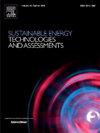Design and thermodynamic analysis of sustainable hybrid system based on solar tower and helium gas cycle for green hydrogen and ammonia production
IF 7.1
2区 工程技术
Q1 ENERGY & FUELS
Sustainable Energy Technologies and Assessments
Pub Date : 2024-11-12
DOI:10.1016/j.seta.2024.104077
引用次数: 0
Abstract
Sustainable energy-based hybrid energy plants hold significant potential for addressing environmental issues and advancing towards a carbon-free future. This research primarily aims to design and evaluate a solar-powered combined cycle for power, hydrogen (H2), and ammonia (NH3) production. This innovatively designed multiple generation system composed of a solar tower (ST), a Brayton cycle (BC) with helium (He) as the fluid, a transcritical Rankine cycle (tRC) powered by carbon dioxide (CO2), organic Rankine cycle (ORC), thermoelectric generator (TEG), a Proton Exchange Membrane (PEM) electrolysis and a NH3 reactor. Thermodynamic analyzes are performed to determine the performance of the entire plant and subsystems. The research analysis revealed that the total net power generation capacity is 4938.15 kW and, the net power production of the sub-systems helium BC, tCO2 RC, ORC and TEG is computed as 4482.03 kW, 100.1 kW, 286.32 kW, and 69.75 kW respectively. Moreover, according to thermodynamic analysis results, H2 and NH3 production rates are 1.7 kg/h and 78 kg/h, respectively. The energetic efficiency of the system is 26.71 % and the exergetic efficiency is 26.16 %. The total exergy destruction in the plant is 13811.39 kW. The highest exergy destruction among the system elements is in the solar tower with 85.3 % (11782.66 kW) of the total exergy destruction. Additionally, the levelized energy cost (LEC) for the system is $0.007 $/kWh and the sustainability index (SI) is 1.37325373.
基于太阳能塔和氦气循环的绿色氢气和氨气生产可持续混合系统的设计和热力学分析
以可持续能源为基础的混合能源工厂在解决环境问题和实现无碳未来方面具有巨大潜力。这项研究的主要目的是设计和评估太阳能发电、制氢(H2)和制氨(NH3)的联合循环。这个创新设计的多发电系统由太阳能塔 (ST)、以氦气 (He) 为流体的布雷顿循环 (BC)、以二氧化碳 (CO2) 为动力的跨临界朗肯循环 (tRC)、有机朗肯循环 (ORC)、热电发电机 (TEG)、质子交换膜 (PEM) 电解和 NH3 反应器组成。热力学分析用于确定整个发电厂和子系统的性能。研究分析表明,总净发电量为 4938.15 kW,氦气 BC、tCO2 RC、ORC 和 TEG 子系统的净发电量分别为 4482.03 kW、100.1 kW、286.32 kW 和 69.75 kW。此外,根据热力学分析结果,H2 和 NH3 的生产率分别为 1.7 kg/h 和 78 kg/h。该系统的能效为 26.71%,效费比为 26.16%。发电厂的总能量损耗为 13811.39 千瓦。在系统元件中,太阳能塔的放能损耗最高,占总放能损耗的 85.3 %(11782.66 千瓦)。此外,该系统的平准化能源成本(LEC)为 0.007 美元/千瓦时,可持续性指数(SI)为 1.37325373。
本文章由计算机程序翻译,如有差异,请以英文原文为准。
求助全文
约1分钟内获得全文
求助全文
来源期刊

Sustainable Energy Technologies and Assessments
Energy-Renewable Energy, Sustainability and the Environment
CiteScore
12.70
自引率
12.50%
发文量
1091
期刊介绍:
Encouraging a transition to a sustainable energy future is imperative for our world. Technologies that enable this shift in various sectors like transportation, heating, and power systems are of utmost importance. Sustainable Energy Technologies and Assessments welcomes papers focusing on a range of aspects and levels of technological advancements in energy generation and utilization. The aim is to reduce the negative environmental impact associated with energy production and consumption, spanning from laboratory experiments to real-world applications in the commercial sector.
 求助内容:
求助内容: 应助结果提醒方式:
应助结果提醒方式:


